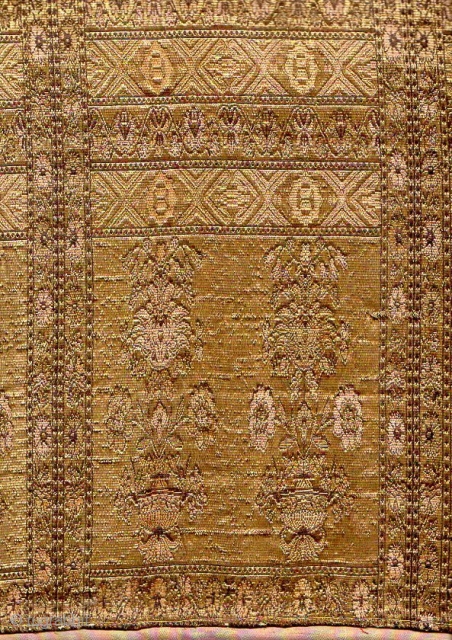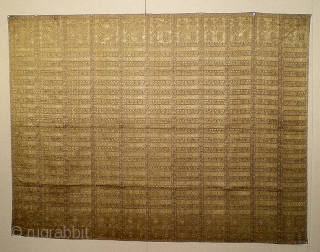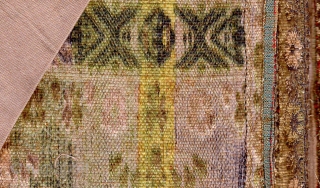Back
Gold Brocaded Panel, Buczacz, Poland, fourth quarter 19th c. 190 x 145 cm.
In 1894, the city of Lwów in Poland (now Lviv, Ukraine) hosted the Exhibition of Home Agriculture and Industries. The high point of this exhibition where the silk hangings from Buczacz.
The Galician town of Buczacz (today: Buchach) was part of southeastern Poland until the end of wwii. In the second half of the 19th c. Oskar and Arthur Potocki, descendants of one of the noblest Polish families, founded there a silk textile factory to produce "typically Polish weavings" mainly intended for the Polish market. The Potockis employed a local family of weavers, the Nagórzański, skilled in the craft for three generations. They furnished their stand at the Exhibition entirely with those silks, which were unanimously praised for their beauty and quality. One of the visitors to the exhibition recounted: “It was for the first time that the Potockis from Buczacz displayed their silks, woven with silver and gold in decorative motifs taken from old Polish sashes and Oriental wall hangings. This was really a small domestic-scale industry, taken up by Arthur, one of the Potocki brothers and an amateur painter himself, but it was very well organized indeed.... Everyone desired to have one of these silks, which were very cheap indeed, but the few on display were sold in an instant, so there were very few lucky buyers.” (Jadwiga Chruszczyńska, Tapestries from Buczacz in the collection of the National Museum in Warsaw, Warsaw: National Museum, 1996, pp. 14–15).
Nowadays very few examples are preserved and they are mainly stored in Museums.This wonderful textile is about 120 years old, it is in good condition and still bears the original tag of the factory sewn on the back, with the ‘pilawa’, the coat of Arms of Polish most noble families. and the initials a.p. for Arthur Potocki.
price:
on request
- Home
- Antique Rugs by Region
- Category
- Profiles
- Post Items Free
- Albums
- Benaki Museum of Islamic Art
- Budapest: Ottoman Carpets
- Gulbenkian Museum
- Islamic Carpets. Brooklyn
- Islamic Textiles. Brooklyn
- Konya Museum: Rugs
- MKG, Hamburg
- MMA: Caucasian Carpets
- MMA: Mamluk Carpets
- MMA: Mughal Indian Carpets
- MMA: Ottoman Carpets
- MMA: Safavid Persian Carpets
- MMA: Turkmen Rugs
- McCoy Jones Kilims
- Ottoman textiles. Met
- Philadelphia Museum
- Rugs and Carpets: Berlin
- Seljuqs at the Met
- TIEM, Istanbul: Carpets
- V&A: Classical Carpets
- Vakiflar Carpets: Istanbul
- Baluch Rugs: Indianapolis
- Gallery Exhibitions
- Jaf an Exhibition
- Alberto Levi Gallery
- Andean Textile
- Christie's London: 2016
- Francesca Galloway
- HALI at 40
- ICOC Washington, DC 2018
- Jajims of the Shahsavan
- London Islamic Week April, 2018
- Mongolian Felts
- Navajo Rugs: JB Moore
- Persian Piled Weavings
- SF Tribal & Textile Art Show 2020
- SF Tribal 2019
- Sotheby's: C. Alexander
- Turkish Prayer Rugs
- Turkmen Main Carpets ICOC 2007













